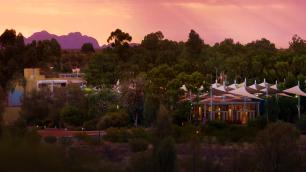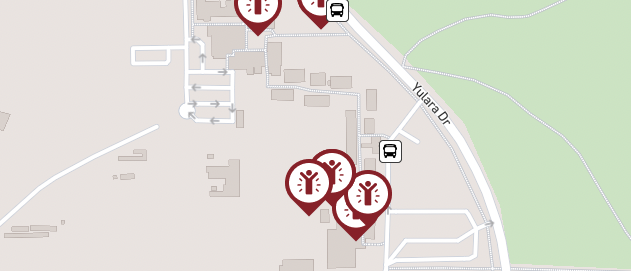About GoCA
At the Gallery of Central Australia (GoCA), we celebrate creativity and culture. We aim to educate and inspire through revolving exhibitions, enriching discussions and shining a light on emerging artists through artist in residence programs
We’re committed to providing a platform for our Indigenous community to share their stories, their culture and we encourage you to join us in exploring one of the oldest living and vibrant cultures.
GoCA is located adjacent to Desert Gardens Hotel.
Open daily from
9:00am – 5:00pm
Daily tour
10:30am

About the Artists
We work with art centres across Central Australia, as well as independent artists and galleries, to showcase the work of emerging Indigenous artists from the region. Community art centres are innovative and vibrant creative spaces where culture is kept alive, passed on between the old and young, and preserved on canvas to share with the world.

Planning your visit
A visit to GoCA provides a unique opportunity to view authentic Indigenous artwork, learn about its significance, and observe artists at work. Admission is free, and guests can purchase authentic artworks at the Gallery to support the dedicated and talented artists and their families who live and work in the Central Desert region. GoCA is located adjacent to Desert Gardens Hotel and is open daily from 9:00 a.m. - 5:00 p.m.
0ef8.jpg?h=bcdfa5ee&itok=OAU6blG7)
Artist in Residence
We are proud to offer Central Australian Indigenous artists an opportunity to take part in our Artist in Residence program. Artists can spend time at the resort, creating, exhibiting and selling their art.
We encourage you to visit GoCA during your stay. You will be in awe of the detail and delicacy as masterpieces, filled with rich stories, come together in front of your eyes.
Artwork Behind the Gallery of Central Australia Logo
%20brumby2572.jpg?itok=NbsgiCnd)
Kapi Tjukurla
Kunmanara (Julie Taria) Brumby
Kapi Tjukurla was designed by Kunmanara (Julie Taria) Brumby, who was a senior woman in the Mutitjulu community, located at Uluru.
The artwork, meaning waterholes in local Pitjantjatjara language, includes concentic circles linked by lines representing waterholes and river courses, the travelling and resting places of Anangu. Dots and lines represent the patterns of desert vegetation. Anangu continues to depend on their extensive knowledge of where and when to find water. This knowledge is informed by Tjukurpa (law and culture), passed on by family and through inma (cultural song and dance).
Brumby's design has been incorporated into GoCA's logo and gallery branding.
Throughout her life, Julie was closely involved with the Uluru-Kata Tjuta National Park, working as a traditional consultant. In this role she would draw on her knowledge of the local environment and culture to advise non-Aboriginal staff and visitors to the Park.
Before her passing in 2019, Julie would regularly visit Walkatjara Community Art Centre where she created beautiful works of art, most often painting the stories of the Seven Sisters, Two Sisters, and stories about the waterholes and the landscape of her traditional lands.
Light Dancing on Waterholes © Julie Brumby












